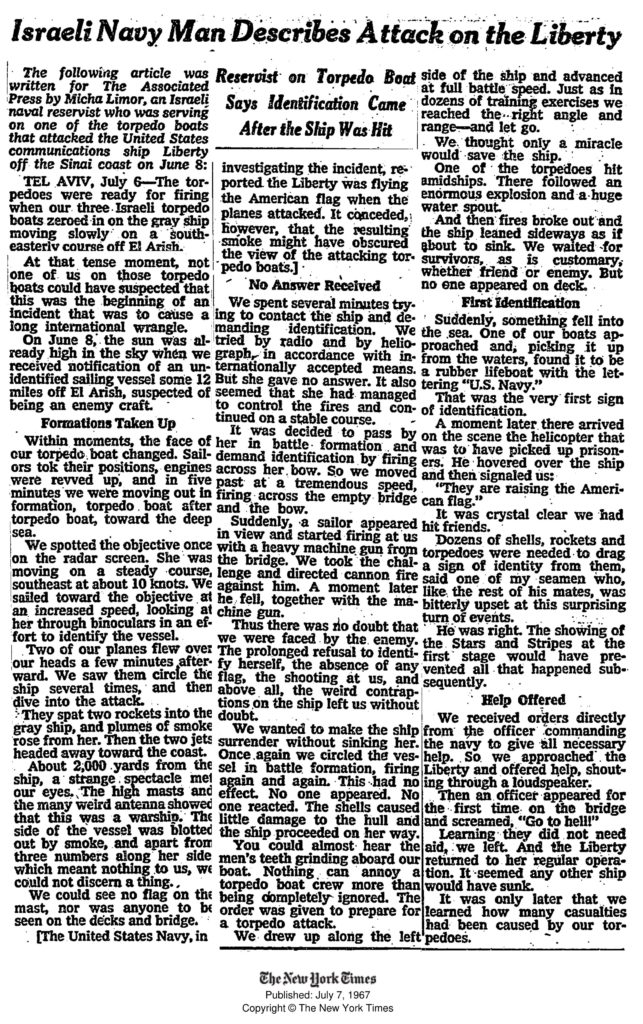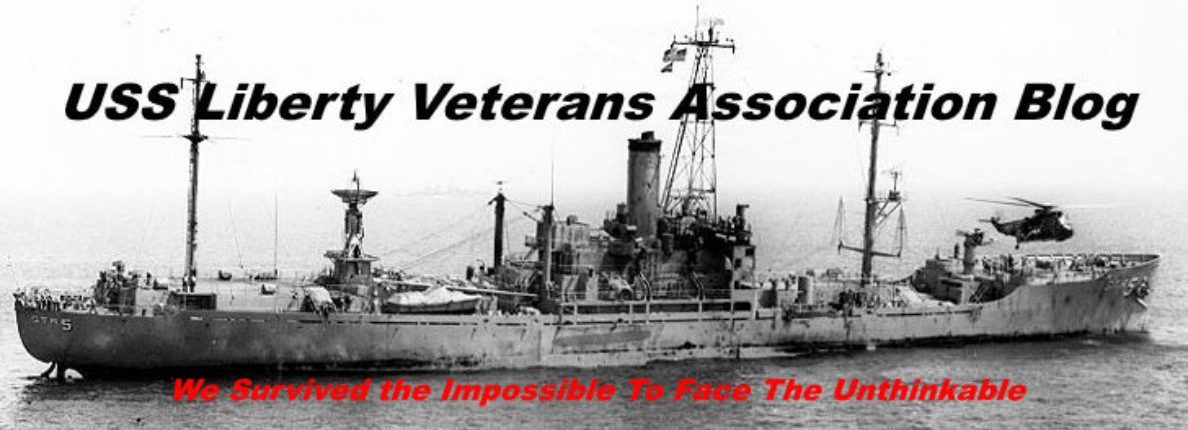His ignorance of the specifics of the attack raises doubts he was there. I’ve heard of wannabes but this is the first I’ve heard of a War Criminal wannabe.
The following article was written for The Associated Press by Micha Limor, described as an Israeli naval reservist who was serving on one of the torpedo boats that attacked the United States communications ship Liberty off the Sinai coast on June 8.

Other accounts describe Limor as an Israeli journalist. Whatever Limor is, he does not appear to have been a witness to the attack as he claims.
Given the article was published on July 7, 1967—less than one month after the attack—Israel partisans cannot claim the passage of time has clouded his memory.
And oh what a memory he has.
He describes circling the ship several times before firing torpedoes, but fails to mention that his torpedo boats approached to within a stone’s throw of the ship then pulled away and continued their attack.
He also omits the fact that his torpedo boats slowly circled the torpedoed and burning ship while firing on USS Liberty crewmen trapped topside and stretcher bearers who ventured topside to help our wounded shipmates.
Limor tells us that the ship flew no flag. Not so. An oversize American flag flew throughout the attack. The torpedomen examined that flag from less than 50 feet away, then continued firing from close range on anything that moved.
Limor tells us that the boatmen offered help. He does not mention that the offer came more than two hours after after the torpedo explosion.
TEL AVIV, July 6—The torpedoes were ready for firing when our three Israeli torpedo boats zeroed in on the gray ship moving slowly on a south-easterly course off El Arish.
At that tense moment, not one of us on those torpedo boats could have suspected that this was the beginning of an incident that was to cause a long international wrangle.1
On June 8, the sun was already high in the sky when we received notification of an unidentified vessel some 12 miles off El Arish suspected of being an enemy craft.2
Formations Taken Up
Within moments, the face of our torpedo boat changed. Sailors took their positions, engines were revved up, and in five minutes we were moving out in formation, torpedo boat after torpedo boat, toward the deep sea.
We spotted the objective once on the radar screen.3 She was moving on a steady course, southeast at about 10 knots. We sailed toward the objective at an increased speed, looking at her through binoculars in an effort to identify the vessel. Two of our planes flew over our heads a few minutes afterward. We saw them circle the ship several times, and then dive into the attack.4
They spat two rockets into the gray ship, and plumes of smoke rose from her. Then the two jets headed away toward the coast.5
About 2,000 yards from the ship, a strange spectacle met our eyes. The high masts and the many weird antennae showed that this was a warship. The side of the vessel was blotted out by smoke, and apart from three numbers along her side, which meant nothing to us, we could not discern a thing.6
`We could see no flag on the mast, nor was anyone to be seen on the decks and bridge.7
[The United States Navy, investigating the incident, reported the Liberty was flying the American flag when the planes attacked. It conceded, however, that the resulting smoke might have obscured the view of the attacking torpedo boats. NYT]8
No Answer Received
We spent several minutes trying to contact the ship and demanding identification. We tried by radio and by heliograph, in accordance with internationally accepted means. But she gave no answer.9 It also seemed that she had managed to control the fires and continued on a stable course.
It was decided to pass by her in battle formation and demand identification by firing across her bow. So we moved past at a tremendous speed, firing across the empty bridge and the bow.10
Suddenly, a sailor appeared in view and started firing at us with a heavy machine gun from the bridge. We took the challenge and directed cannon fire against him. A moment later, he fell together with the machine gun.11
Thus, there was no doubt that we were faced by the enemy. The prolonged refusal to identify herself, the absence of any flag, the shooting at us and, above all, the weird contraptions on the ship left us without doubt.
We wanted to make the ship surrender without sinking her. Once again, we circled the vessel in battle formation, firing again and again. This had no effect. No one appeared. No one reacted. The shells caused little damage to the hull, and the ship proceeded on her way.12
You could almost hear the men’s teeth grinding aboard our boat. Nothing can annoy a torpedo boat crew more than being completely ignored. The order was given to prepare for a torpedo attack.
We drew up along the left side13 of the ship and advanced at full battle speed. Just as in dozens of training exercises, we reached the right angle and range—and let go. We thought only a miracle would save the ship. One of the torpedos hit amidships. There followed an enormous explosion and a huge water spout.
And then fires broke out, and the ship leaned sideways as if about to sink. We watched for survivors, as is customary, whether friend or enemy. But no one appeared on deck.
First Identification
Suddenly, something fell into the sea. One of our boats approached and, picking it up from the waters, found it to be a rubber lifeboat with the lettering “U.S. Navy.”14
That was the very first sign of identification.
A moment later there arrived on the scene the helicopter that was to have picked up prisoners.15 He hovered over the ship and then signaled us:
“They are raising the American flag.”
It was crystal clear we had hit friends.
Dozens of shells, rockets and torpedoes were needed to drag a sign of identity from them, said one of my seamen who, like the rest of his mates, was bitterly upset at this turn of events.
He was right. The showing of the Stars and Stripes at the first stage would have prevented all that happened subsequently.
Help Offered
We received orders directly from the officer commanding the navy to give all necessary help. So we approached the Liberty and offered help through a loudspeaker.
Then an officer appeared for the first time on the bridge and screamed, “Go to hell!”
Learning they did not need aid, we left. And the Liberty returned to her regular operations. It seemed any other ship would have sunk.
It was only later that we learned how many casualties had been caused by our torpedoes.
END
